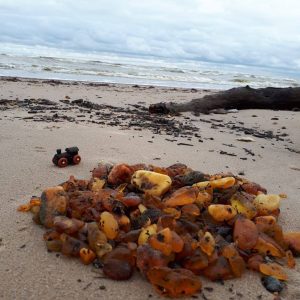The Alpine region can boast about being rich with Alpine Quartz, Finland can be proud of its Spectrolite (Labradorite), Brazil and Uruguay about dark purple Amethyst etc. Everyone has something that is local and famous. Well, us in the Baltics, we have something too - Baltic Amber.
In short, Baltic amber is just amber that comes from this region and can be found on the beaches of countries that lay next to the Baltic Sea. It’s a cold, windy, dark sea that coughs up some of the most sought after gems in the world. Like most amber, Baltic amber is about 33-60 million years.
Baltic amber has formed mostly from pine tree resin that ‘bled’ out in a temperature of about plus 25 degrees celsius and slowly hardened up over time. All of this happened when Europe was still a tropical continent. Amber, of course, can be found in many places, but just so happens that it is easily accessible in this region. For example, in Kaliningrad alone (Old Prussian lands) about 90% of all amber gets mined, about 700 tons per year. You can estimate that in every cubic metre of clay in this region, you will find around 1,2-2,5kg of amber, some pieces weighing a few kilograms.
You can still find pieces of amber on the beach, especially in Western Latvia, more specifically Liepaja. My dad has told me stories of going to the beach as a kid and coming home with a handful of amber, not thinking much of it. It’s a bit more difficult now than it would have been in his days, but still very much possible. We still hear stories of huge pieces of amber being washed up and found by fisherman and children playing on the beach, like these ones here.
Just a side note - be careful when picking amber around Liepaja. In the Soviet times the regime tested bombs containing white phosphorus, which looks similar to amber and ended up in the Baltic Sea. But unlike amber, white phosphorus is highly flammable and can catch fire in your pocket and burn you. If not sure, rub it and see if it smokes up.
While we’re on this topic - real amber melts when it’s heated or burned and smells amazing. While there is no archeological evidence that I am aware of, it is thought that powdered amber would be burnt to protect from evil, is thought to be healing and generally cleansing. Sort of like common sage.
Historically, it has always been a very valuable trading good that the people of this region sold to Romans and Greeks, who called it electron - a term also used for a gold/silver mix in a single unit.
Everyone knows of the ‘Silk Road’, but not many people know that an equally impressive trade route came out of the Baltics and was called the Amber road. The Baltic tribes grew rich and powerful from the Amber trade and can be recognised by amber jewellery. Jewellery was easy to make as amber is a light, soft ‘stone’ and could be easily carved and shaped.
It was a luxury item with high demand for it across the known world at the time as the Baltic Sea provided amber with beautiful clarity, natural pieces with bugs in them etc. Accessories made of Baltic Amber have been found in archeological sites in places such as Italy, Greece, Egypt, Syria, Iraq, Iran and even China.
It’s our Baltic Gold and it’s the best in the world.
